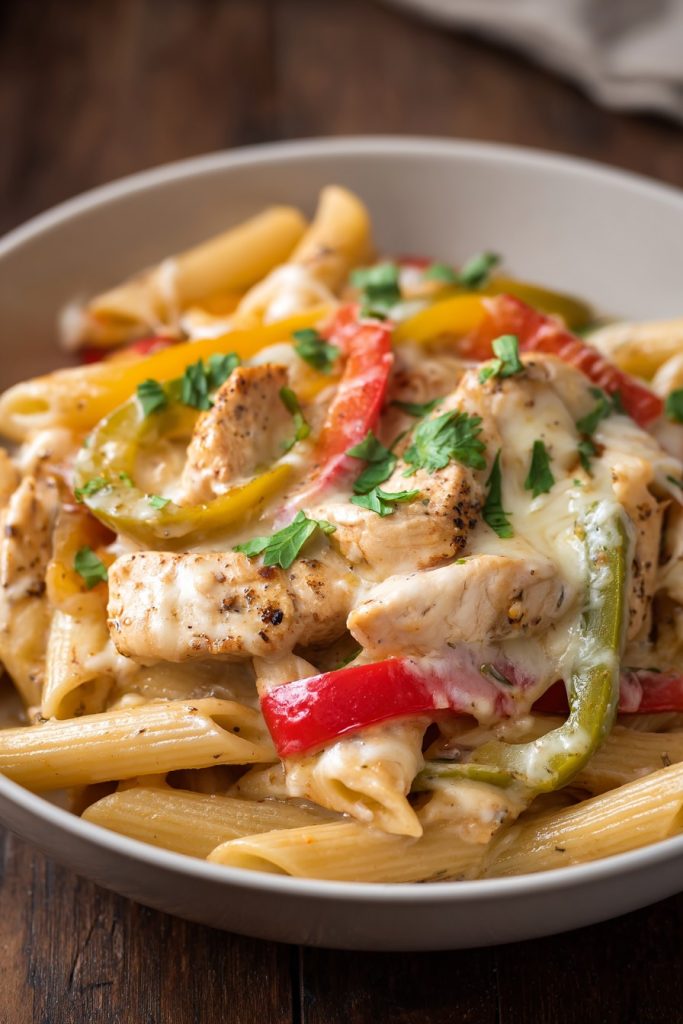Sick of the same old taco Tuesday routine? So was I until I had the brilliant idea to combine the sizzling flavors of chicken fajitas with the comforting embrace of pasta. Seriously, this dish is like a fiesta in your mouth that decided to move in permanently and pay rent in deliciousness. It’s the ultimate fusion that’ll make your taste buds do the cha-cha while keeping your weeknight dinner game strong.
Why This Recipe Works
- The marinade does double duty by flavoring both the chicken and the sauce, creating a cohesive and deeply seasoned dish from start to finish without extra steps.
- Using both fresh bell peppers and onions alongside fajita seasoning ensures authentic Tex-Mex flavor that store-bought seasoning packets alone can’t achieve, giving you control over salt and spice levels.
- Cooking the pasta directly in the sauce allows it to absorb all the delicious flavors rather than just being coated, resulting in every single bite being packed with fajita goodness from the inside out.
- The addition of cream cheese and heavy cream creates a luxuriously creamy sauce that clings perfectly to the pasta without making it overly heavy or greasy, striking the ideal balance between indulgence and freshness.
- Finishing with fresh lime juice and cilantro brightens up the entire dish, cutting through the richness and adding that essential fresh element that makes it taste restaurant-quality rather than home-cooked comfort food.
Ingredients
- 1.5 pounds boneless, skinless chicken breasts, cut into 1-inch cubes
- 3 tablespoons olive oil, divided
- 2 tablespoons fajita seasoning (homemade or store-bought)
- 1 large yellow onion, thinly sliced
- 2 large bell peppers (1 red, 1 green), thinly sliced
- 4 cloves garlic, minced
- 1 pound penne pasta
- 4 cups chicken broth
- 1 cup heavy cream
- 4 ounces cream cheese, cubed and softened
- 1 cup shredded Monterey Jack cheese
- 1/4 cup fresh cilantro, chopped
- 2 tablespoons fresh lime juice
- Salt and black pepper to taste
- Optional toppings: sliced avocado, sour cream, extra cilantro
Equipment Needed
- Large skillet or Dutch oven (at least 12 inches)
- Cutting board and sharp knife
- Measuring cups and spoons
- Wooden spoon or spatula
- Tongs
- Mixing bowls
- Citrus juicer
Instructions

Marinate the Chicken
In a medium bowl, combine your cubed chicken breasts with 2 tablespoons of olive oil and all of the fajita seasoning. Use your hands or tongs to really massage that seasoning into every nook and cranny of the chicken—this isn’t the time to be shy! Make sure each piece is evenly coated with that beautiful rust-colored spice blend. Let it sit for at least 15 minutes at room temperature (or up to 2 hours in the refrigerator if you’re planning ahead) to allow the flavors to penetrate the meat. The acid in the seasoning will start tenderizing the chicken while the oil helps carry those flavors deep into the protein. Tip: If you have time, marinating for the full 2 hours will give you even more flavorful and tender chicken, but even 15 minutes makes a noticeable difference compared to adding seasoning during cooking.
Sauté Vegetables Until Perfectly Tender-Crisp
Heat your remaining 1 tablespoon of olive oil in a large skillet or Dutch oven over medium-high heat until it shimmers—you should see little waves forming in the oil when you tilt the pan. Add your thinly sliced onions and bell peppers and cook, stirring occasionally, for about 6-8 minutes. You’re looking for the onions to become translucent around the edges and the peppers to soften slightly while still maintaining some crunch. They should have a few golden brown spots but not be mushy—we want that perfect fajita vegetable texture where they’re cooked through but still have personality. About halfway through, add your minced garlic and cook for just 30 seconds until fragrant—be careful not to burn it! The garlic should smell amazing but not turn brown.
Cook Chicken to Golden Perfection
Push your vegetables to the sides of the pan, creating a well in the center. Add your marinated chicken in a single layer—don’t overcrowd the pan or you’ll steam rather than sear the chicken. Let it cook undisturbed for 3-4 minutes until a golden brown crust forms on the bottom—resist the urge to stir too early! Flip the pieces and cook for another 3-4 minutes until the chicken is cooked through and no longer pink in the center. The internal temperature should reach 165°F when checked with an instant-read thermometer. The chicken should be juicy and flavorful with those beautiful seared edges that only proper browning can create. Tip: If your pan isn’t large enough to cook all the chicken at once, work in batches to avoid overcrowding and ensure proper browning.
Create the Creamy Sauce Base
Reduce the heat to medium and add your penne pasta directly to the skillet along with the chicken broth. Use your wooden spoon to scrape up any browned bits from the bottom of the pan—that’s pure flavor gold right there! Bring the mixture to a gentle boil, then reduce the heat to maintain a steady simmer. Cover and cook for 12-15 minutes, stirring occasionally, until the pasta is al dente and most of the liquid has been absorbed. The pasta should be tender but still have a slight bite to it—remember it will continue cooking a bit in the residual heat. You’ll notice the sauce starting to thicken naturally from the pasta starch releasing into the liquid.
Incorporate Creamy Elements
Stir in the heavy cream and cubed cream cheese until the cream cheese has completely melted and the sauce becomes smooth and luxurious. This should take about 2-3 minutes of constant stirring—make sure to get into the corners of the pan where cream cheese might hide. The sauce will transform from brothy to creamy right before your eyes! Add the shredded Monterey Jack cheese and stir until it’s fully melted and incorporated, creating that stretchy, cheesy goodness we all love. The sauce should coat the back of a spoon nicely at this point. Tip: For an extra smooth sauce, make sure your cream cheese is at room temperature before adding it—cold cream cheese can take longer to melt and might leave little lumps.
Finish with Fresh Flavors
Remove the skillet from the heat and stir in the fresh lime juice and chopped cilantro. Taste and season with salt and black pepper as needed—remember that cheeses and broth can be salty, so taste before adding more salt. The lime juice will brighten up the entire dish and cut through the richness of the cream, while the cilantro adds that fresh, herbal note that makes fajitas so irresistible. Let the pasta rest for 2-3 minutes before serving—this allows the sauce to thicken slightly and the flavors to meld together perfectly. Serve immediately with your favorite toppings like sliced avocado, a dollop of sour cream, or extra cilantro for those who want to go big on the fresh herbs.
Tips and Tricks
If you want to take this dish to the next level, consider making your own fajita seasoning blend—it’s surprisingly easy and lets you control the salt and spice levels perfectly. Combine 1 tablespoon chili powder, 2 teaspoons cumin, 2 teaspoons paprika, 1 teaspoon garlic powder, 1 teaspoon onion powder, 1 teaspoon oregano, 1/2 teaspoon cayenne (adjust for heat preference), and 1 teaspoon salt. This makes enough for this recipe with a little leftover for your next fajita adventure. Store it in an airtight container for up to 3 months. For the creamiest possible sauce, consider using full-fat products—the higher fat content in heavy cream and full-fat cream cheese creates a more stable emulsion that’s less likely to break or become greasy. If you’re watching calories, you can use half-and-half instead of heavy cream and neufchâtel cheese instead of cream cheese, but the texture will be slightly less luxurious. When slicing your vegetables, try to keep them uniform in thickness—this ensures they cook at the same rate. I like to slice my onions and peppers about 1/4-inch thick for the perfect balance between tender and crisp. If you’re meal prepping, this pasta holds up surprisingly well—store it in an airtight container in the refrigerator for up to 4 days. The sauce will thicken as it cools, so when reheating, add a splash of chicken broth or milk to loosen it up while warming gently over medium-low heat, stirring frequently. Avoid boiling when reheating as this can cause the dairy to separate. For a deeper flavor profile, try charring your bell peppers directly over a gas flame or under the broiler before slicing—this adds a smoky dimension that plays beautifully with the fajita spices. Just place whole peppers directly on the flame, turning with tongs until blackened on all sides, then transfer to a bowl covered with plastic wrap to steam for 10 minutes before rubbing off the blackened skin and slicing. If you’re feeding a crowd, this recipe doubles beautifully—just make sure you’re using a pot large enough to accommodate everything, or cook in batches. Finally, don’t skip the rest time at the end—those few minutes allow the pasta to absorb excess liquid and the flavors to marry properly, resulting in a better texture and more cohesive taste experience.
Recipe Variations
- For a seafood twist, substitute the chicken with 1.5 pounds of large shrimp (peeled and deveined) or scallops. Add them in the last 5 minutes of cooking since seafood cooks much faster than chicken—just until pink and opaque. The briny sweetness of seafood pairs wonderfully with the fajita spices and creamy sauce, creating a surf-and-turf vibe without the turf.
- Make it vegetarian by replacing the chicken with an extra bell pepper and 8 ounces of sliced mushrooms, and use vegetable broth instead of chicken broth. Add the mushrooms when you sauté the vegetables—they’ll release liquid and create a meaty texture that stands up well to the robust flavors. You could also add a can of black beans (rinsed and drained) at the same time as the cream for extra protein.
- For a spicier version, add 1-2 diced jalapeños (seeds removed for less heat or included for more fire) when sautéing the vegetables. You can also increase the cayenne in your seasoning blend or add a tablespoon of chipotle peppers in adobo sauce (minced) for that smoky heat that makes your nose run in the best way possible.
- Try different pasta shapes—fettuccine, rigatoni, or farfalle all work beautifully. Just adjust the cooking time according to package directions since different shapes have different cooking times. Smaller shapes like rotini will hold the sauce in their crevices, while longer shapes like fettuccine will wrap around the chicken and vegetables elegantly.
- For a lighter version, replace the heavy cream with half-and-half and use reduced-fat cream cheese. You can also use whole wheat or chickpea pasta for extra fiber and protein. The sauce will be slightly less rich but still delicious, and you’ll save about 200 calories per serving without sacrificing too much flavor.
Frequently Asked Questions
Can I make this dish ahead of time?
Absolutely! This chicken fajita pasta actually reheats surprisingly well, making it perfect for meal prep. Store it in an airtight container in the refrigerator for up to 4 days. When reheating, add a splash of chicken broth or milk to loosen the sauce since it will thicken as it cools. Warm it gently over medium-low heat on the stove, stirring frequently, until heated through—avoid boiling as high heat can cause the dairy to separate. You can also reheat individual portions in the microwave at 50% power, stirring every minute until hot. The pasta may soften slightly upon reheating, but the flavors often improve after resting overnight.
What can I use if I don’t have fajita seasoning?
No worries—you can easily create a substitute with common pantry spices. Combine 1 tablespoon chili powder, 2 teaspoons ground cumin, 2 teaspoons paprika, 1 teaspoon garlic powder, 1 teaspoon onion powder, 1 teaspoon dried oregano, 1/2 teaspoon cayenne pepper (adjust to your heat preference), and 1 teaspoon salt. This mixture will give you that authentic Tex-Mex flavor profile. If you’re in a real pinch, you can use taco seasoning, but reduce the salt in the recipe since taco seasoning tends to be saltier than fajita seasoning. The flavor will be slightly different but still delicious—think of it as taco pasta instead of fajita pasta!
How can I prevent my sauce from breaking or becoming greasy?
The key to a smooth, non-greasy sauce is temperature control and proper incorporation of dairy. Make sure to reduce the heat to medium before adding the cream and cream cheese—adding dairy to boiling liquid can cause it to separate. Also, ensure your cream cheese is at room temperature and cubed small so it melts evenly without clumping. Stir constantly while incorporating the dairy until it’s fully emulsified. If your sauce does break slightly, you can often save it by removing it from the heat and whisking in a tablespoon of cold butter or a splash of cold cream—the sudden temperature change can help bring the emulsion back together.
Can I freeze this pasta dish?
I don’t recommend freezing this particular recipe because cream-based sauces with dairy tend to separate and become grainy when frozen and thawed. The pasta also becomes mushy upon reheating from frozen. However, you can freeze components separately—the marinated chicken raw or cooked, and the sautéed vegetables. Then when ready to eat, you can make fresh pasta and sauce and combine everything. If you must freeze the completed dish, expect some texture changes—the sauce may need to be blended after thawing to smooth it out, and the pasta will be much softer.
What’s the best way to slice the chicken and vegetables for this recipe?
For optimal cooking and eating experience, slice your chicken into uniform 1-inch cubes—this ensures even cooking so some pieces aren’t overcooked while others are underdone. For the vegetables, slice your onions and bell peppers into 1/4-inch thick strips. Try to keep them relatively uniform so they cook at the same rate. I find that slicing the peppers lengthwise (from stem to bottom) rather than crosswise gives you nicer strips that hold their shape better during cooking. Using a sharp knife makes all the difference—dull knives crush rather than slice, releasing more moisture and making vegetables soggy.
Summary
This chicken fajita pasta combines weeknight convenience with restaurant-worthy flavors, featuring tender marinated chicken, crisp-tender vegetables, and a luxuriously creamy sauce that clings perfectly to every bite of pasta. It’s the ultimate comfort food with a Tex-Mex twist that will have everyone coming back for seconds.
Chicken Fajita Pasta
5
servings20
minutes30
minutesIngredients
Instructions
- 1 Marinate chicken with 2 tbsp olive oil and fajita seasoning for 15 minutes.
- 2 Sauté onions and peppers in remaining oil for 6-8 minutes, add garlic last 30 seconds.
- 3 Cook chicken in single layer until golden brown and cooked through, 6-8 minutes total.
- 4 Add pasta and broth, simmer covered for 12-15 minutes until pasta is al dente.
- 5 Stir in cream and cream cheese until smooth, then add Monterey Jack until melted.
- 6 Remove from heat, stir in cilantro and lime juice, season to taste, rest 2 minutes.



